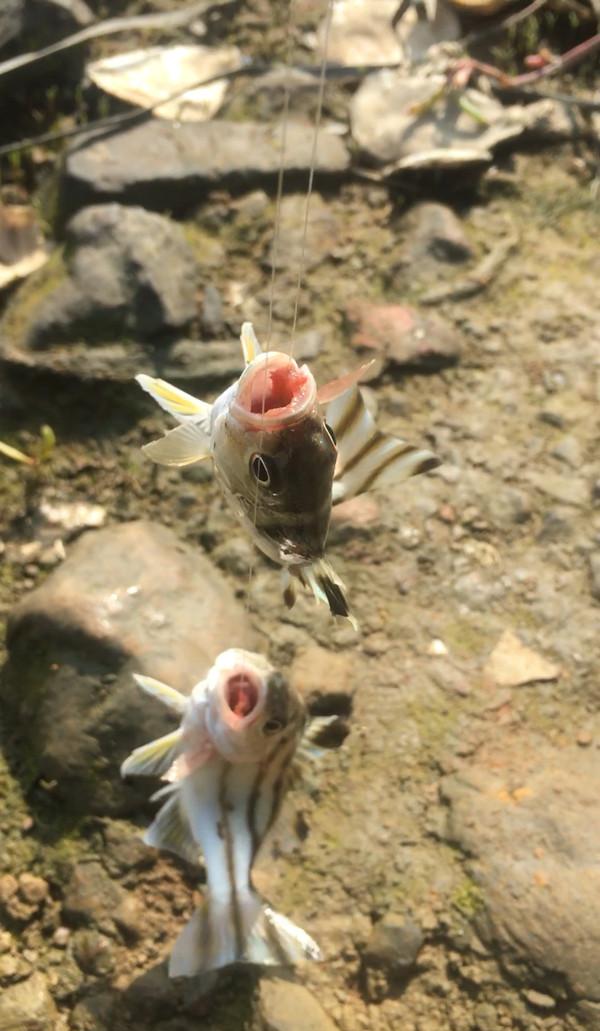
In the early years, anglers were fishing for chicken fish on the beach, when the offshore environment was not polluted, and there were often several hooks in the fishing sets used by everyone, so several fish could be caught at a time, and the average individual catch was 15 to 20 centimeters. Although the individual body of the chicken fish is not large, the pull is extremely strong, and it can often pull the thin rod used for beach fishing and nod it violently. Perhaps many anglers do not know, in fact, the flower body chicken fish is also a good object fish, the following I will introduce this fish species and fishing methods in detail for anglers.
First, the ecological habits of the flower-bodied chicken fish
It belongs to the rayfin fish, perch and pimpaceae, and is widely distributed in the east coast of Africa in the Indian Ocean, the Red Sea, Australia, Korea, Japan, the South China Sea, the Taiwan Strait, the East China Sea and other waters, and belongs to tropical and subtropical warm water benthic fish. They live in shallow coastal areas near sandy bottoms, gravel floors or reefs, and can also survive in brackish water environments.
The Chinese scientific name of the flower body chicken fish is "flower body steamed bun", this fish is also known as the fine scaled fish, and there are also common names such as flower body boy, spotted, chicken fish, three scratch boy, sea wasp, spotted pig and so on. The pheasant has the characteristics of perch species: flattened body, with a distinct spike on the gill lid; silvery brown body with 3 dark brown arc-shaped longitudinal bands; a large black spot on the dorsal fin, slightly concave tail fin, with three or four longitudinal bands, the appearance of this species is similar to that of striped bristles, but the latter's body-side longitudinal band is linear, and the tail fin has 5 longitudinal bands. The spines on the first dorsal fin of the chicken fish are very hard, and there are spines on the posterior edge of the gill cap, which is a good self-defense weapon, and anglers who do not understand the situation often suffer losses when catching fish.
The adult flower body chicken fish can reach a length of 36 cm, and the body surface pattern of small fish with a body length of less than 15 cm is very obvious. But as they age, the pattern on their body surface will gradually disappear and be replaced by a gray and dark body color. Experienced anglers can guess the approximate age of chicken fish by looking at the color of their body surface.
The growth characteristic of the flower chicken fish is "first female and then male", which belongs to the sexual transformation fish. From April to June every year, when the water temperature in the waters of Taiwan reaches 23 ° C ~ 26 degrees Celsius, the chicken fish will spawn, the broodstock will migrate to the sea of 20 to 30 meters deep to spawn, and the number of eggs held by each broodstock is about 15,000, and the eggs can be laid twice a year. The fertilized eggs of the flower chicken fish are floating eggs, which can be hatched in 1 to 2 days, and the hatched calves can metamorphose into juveniles after two or three days, and can begin to migrate to the estuary area and warm waters on the shore.
Ferocious and gluttonous, the chicken fish is a strong swimmer, they are carnivorous fish, with small benthic invertebrates as their main food. Chicken fry with a body length of less than 2 cm feed on planktonic flexural and terminal foot creatures, and as they grow in size, when they actually become benthic fish, they feed on shrimp, crabs, molluscs and other small fry.
The chicken fish have high activity and natural self-defense weapons, so they have a sense of territory and a strong ability to grab food. They often go to or sneak at the angler's bait so that the angler cannot catch the target fish, so the chicken fish is one of the most troublesome troublemakers for anglers. So, how do we catch this kind of trickster? This starts with fishing tackle.

Second, suitable for fishing gear
For the frequent activities in the swimming layer of 1 to 25 meters deep, I would like to recommend a few suitable fishing gear for you.
1. Fishing rod: 1.98 meters or 2.1 meters long L-adjusted straight handle road rod, suitable for bait weight of 4 to 10 grams, fishing line load of 4 to 8 pounds.
2. Fishing wheel: 1000 type spinning wheel can be, the discharge smooth is the best, the capacity of the cable cup is 0.8 PE line 120 meters or 1.0 PE line 100 meters.
3. Bait: 3 to 5 grams of single hook sequins, 1.5 to 2 inches long capuchin maggot soft bait with 1.5 to 5 grams of lead head hook, 4 to 5 cm long slow sinking fish shape bait or ultra-small rotating sequins with a length of less than 4 cm can be used.
3. Fishing techniques
1. If the angler is not sure whether the chicken fish is in the area of their choice, they can first search with a small fish-shaped bait. The eating of the chicken fish is very fierce, even if they just gently bite the bait, it will produce a very obvious feeling of embarrassment, and they are mostly deep swallowing when taking the bait, which must be noted.
2. Capuchin maggot baits with lead-headed hooks can be effective in punctuation at low tide levels, such as in some drainage canals leading to the sea or punctuation such as lagoons.
3. When fishing for chicken fish, the bait is very easy to hang on the bottom or be swallowed deeply, so we should pay attention to it when choosing bait and choosing fishing points.